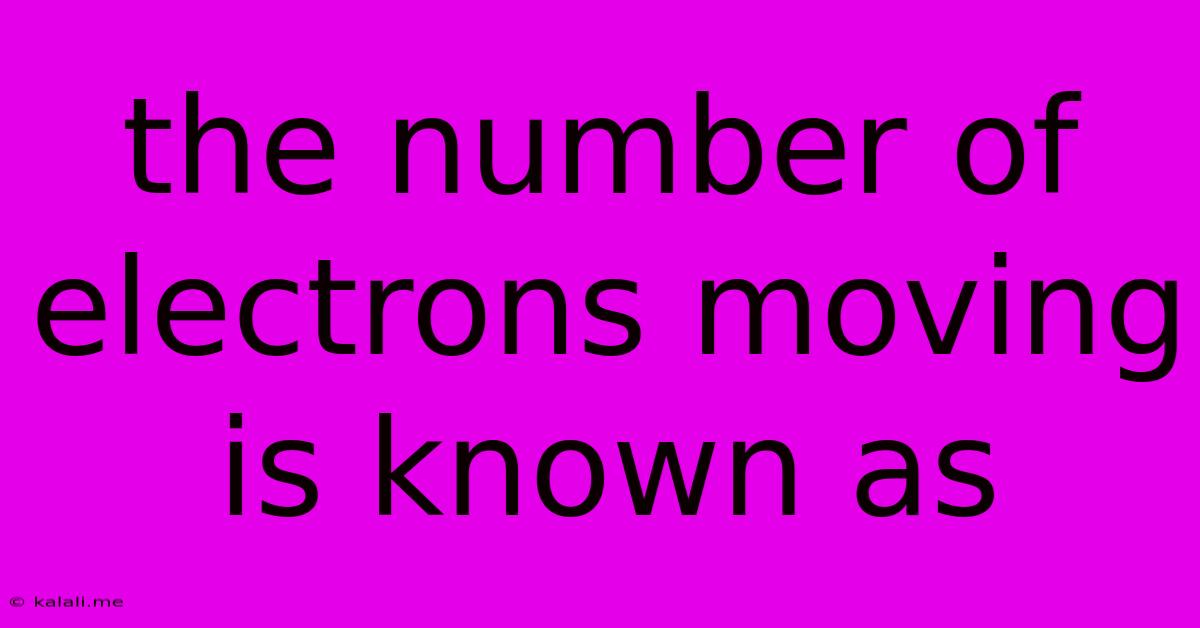The Number Of Electrons Moving Is Known As
Kalali
Jun 06, 2025 · 3 min read

Table of Contents
The Number of Electrons Moving: Understanding Current and its Measurement
The number of electrons moving is known as electric current. This fundamental concept in electricity describes the rate at which electric charge flows past a point in an electrical circuit. Understanding current is crucial to grasping the principles behind how electricity works in everything from simple circuits to complex electronic devices. This article delves into the definition of current, how it's measured, and its relationship to other electrical quantities.
What is Electric Current?
Electric current is essentially the flow of electric charge. This charge is carried by moving electrons, the negatively charged subatomic particles found in atoms. When a potential difference (voltage) is applied across a conductor, such as a wire, these electrons are pushed along the conductor, creating a flow of charge. The higher the voltage, the greater the force pushing the electrons and therefore, the higher the current.
The current is not about the total number of electrons present, but rather the rate at which they are moving past a particular point. Think of it like a river: the total amount of water in the river is irrelevant; what matters is the flow rate – how much water passes a certain point per unit of time.
Measuring Electric Current
Electric current is measured in amperes (A), often shortened to "amps". One ampere is defined as one coulomb of charge passing a point in one second. A coulomb is a unit of electric charge, representing approximately 6.24 x 10<sup>18</sup> electrons. Therefore, a current of one ampere means that 6.24 x 10<sup>18</sup> electrons are flowing past a point every second.
Factors Affecting Electric Current
Several factors influence the magnitude of electric current in a circuit:
-
Voltage (V): As mentioned earlier, a higher voltage leads to a stronger driving force for electrons, resulting in a higher current. This relationship is described by Ohm's Law: I = V/R, where I is current, V is voltage, and R is resistance.
-
Resistance (Ω): Resistance is a measure of how much a material opposes the flow of electric current. Materials with high resistance impede the flow of electrons, resulting in lower current. Insulators have very high resistance, while conductors have low resistance.
-
Material Properties: The type of material used in the conductor significantly impacts its resistance and thus the current flow. Copper, for instance, is a good conductor with low resistance, allowing for high current flow.
-
Temperature: Temperature also affects resistance. In most conductors, resistance increases with increasing temperature.
Types of Electric Current
There are two main types of electric current:
-
Direct Current (DC): DC flows in one direction only. Batteries are a common source of DC.
-
Alternating Current (AC): AC periodically reverses its direction. This is the type of electricity that is typically supplied to homes and businesses.
Understanding the number of electrons moving, or electric current, is fundamental to comprehending electrical circuits and their applications. By grasping the concepts of current, voltage, and resistance, you can better understand and utilize electricity safely and efficiently. Furthermore, delving into the different types of current helps to clarify the many applications of electricity in various fields and technologies.
Latest Posts
Latest Posts
-
What Is A Word For Someoen Relying On Someone Else
Jun 06, 2025
-
Removing Flow Restrictor From Shower Head
Jun 06, 2025
-
How Much Xp Does Zombie Give
Jun 06, 2025
-
Is Saying Thank God A Sin
Jun 06, 2025
-
Wii Games That Use Classic Controller
Jun 06, 2025
Related Post
Thank you for visiting our website which covers about The Number Of Electrons Moving Is Known As . We hope the information provided has been useful to you. Feel free to contact us if you have any questions or need further assistance. See you next time and don't miss to bookmark.